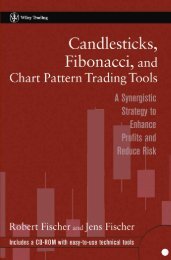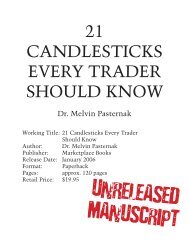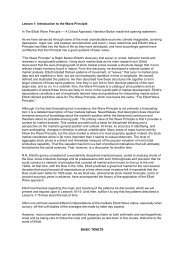The Ultimate Technical Analysis Handbook - Tradingportalen.com
The Ultimate Technical Analysis Handbook - Tradingportalen.com
The Ultimate Technical Analysis Handbook - Tradingportalen.com
You also want an ePaper? Increase the reach of your titles
YUMPU automatically turns print PDFs into web optimized ePapers that Google loves.
Chapter 1 — How the Wave Principle Can Improve Your Trading<br />
3. Determines Maturity of a Trend<br />
As Elliott observed, wave patterns form<br />
larger and smaller versions of themselves.<br />
This repetition in form means that<br />
price activity is fractal, as illustrated in<br />
Figure 1. Wave (1) subdivides into five<br />
small waves, yet is part of a larger fivewave<br />
pattern. How is this information<br />
useful? It helps traders recognize the<br />
maturity of a trend. If prices are advancing<br />
in wave 5 of a five-wave advance<br />
for example, and wave 5 has already<br />
<strong>com</strong>pleted three or four smaller waves,<br />
a trader knows this is not the time to add<br />
long positions. Instead, it may be time<br />
to take profits or at least to raise protective<br />
stops.<br />
Figure 1<br />
Since the Wave Principle identifies trend, countertrend, and the maturity of a trend, it’s no surprise that<br />
the Wave Principle also signals the return of the dominant trend. Once a countertrend move unfolds in<br />
three waves (A-B-C), this structure can signal the point where the dominant trend has resumed, namely,<br />
once price action exceeds the extreme of wave B. Knowing precisely when a trend has resumed brings<br />
an added benefit: It increases the probability of a successful trade, which is further enhanced when<br />
ac<strong>com</strong>panied by traditional technical studies.<br />
4. Provides Price Targets<br />
What traditional technical studies simply<br />
don’t offer — high probability price<br />
targets — the Wave Principle again<br />
provides. When R.N. Elliott wrote about<br />
the Wave Principle in Nature’s Law, he<br />
stated that the Fibonacci sequence was<br />
the mathematical basis for the Wave<br />
Principle. Elliott waves, both impulsive<br />
and corrective, adhere to specific<br />
Fibonacci proportions in Figure 2. For<br />
example, <strong>com</strong>mon objectives for wave<br />
3 are 1.618 and 2.618 multiples of wave<br />
1. In corrections, wave 2 typically ends<br />
near the .618 retracement of wave 1, and<br />
wave 4 often tests the .382 retracement<br />
of wave 3. <strong>The</strong>se high probability price<br />
targets allow traders to set profit-taking<br />
objectives or identify regions where the<br />
next turn in prices will occur.<br />
Figure 2<br />
<strong>The</strong> <strong>Ultimate</strong> <strong>Technical</strong> <strong>Analysis</strong> <strong>Handbook</strong> — © 2009 Elliott Wave International<br />
This ebook includes handpicked lessons from more than 200 pages of EWI’s <strong>com</strong>prehensive<br />
Trader’s Classroom Collection of eBooks. Learn more here: http://www.elliottwave.<strong>com</strong>/wave/ClubTCC<br />
4





